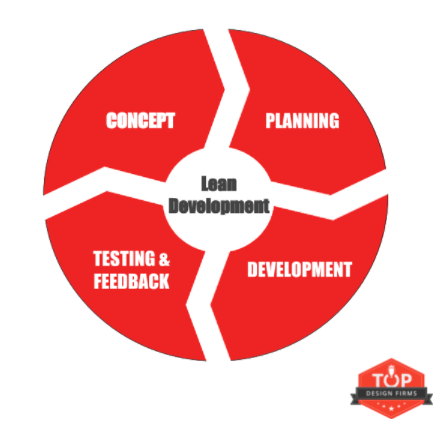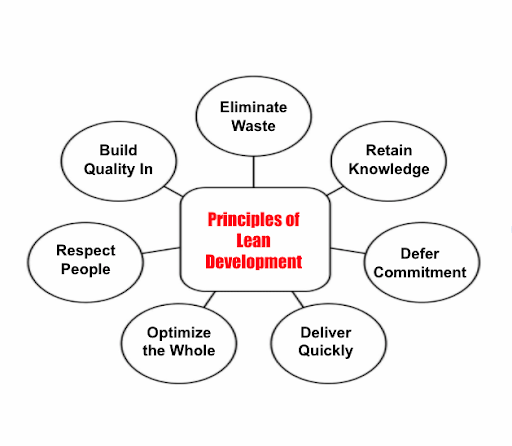7 Principles of Lean Software Development
Lean software development focuses on producing high-quality work with less waste. In doing so, this methodology helps development teams save valuable time and reduce the costs of projects. Follow these 7 principles in order to deliver a better product.
Need help selecting a company?
Based on your budget, timeline, and specifications we can help you build a shortlist of companies that perfectly matches your project needs. Get started by submitting your project details.
What is Lean Software Development?
Lean software development (LSD) is an agile framework that allows companies to optimize how they use time and resources while developing a product.
To do this, software development teams create the minimum viable product (MVP), or an early version of a software product that has just enough features to validate an idea and collect user feedback.

Once they’ve collected data, they are able to iterate on user feedback, add components and make changes as needed. By focusing on essential elements, they’re able to provide higher-quality work with a better user experience in the long run.
Read, ‘What Is The Best Software Development Model for My Project?’
5 Benefits of Lean Software Development
- Save money
- Doesn’t require as many resources
- Faster development time
- Prevent waste
- Functionality provides more value to customers
Often used with other agile methodologies like Scrum or kanban, a lean approach streamlines the development process. By getting rid of unnecessary development stages and focusing on the features that drive the most value to users, teams are able to save time and money.

Source: Google Play
Andrei Kryssov, a product manager for Vimeo, explains why their software developers follow a lean methodology:
“The primary benefit of this approach is that it shortens your development time window. This is a huge advantage if you’re uncertain about the exact feature set that you’re building,” he continues, “The other benefit is that you can quickly ship something and get it in the hands of your customers for feedback.”
This feedback allows companies to focus on the elements that will provide the most value. Rather than spending time and money on features that users don’t like or are ineffective, companies know exactly how to allocate their resources.
In fact, it’s estimated that lean development projects are completed 3 times faster than projects developed using other models.
This makes it one of the best ways for companies with a limited budget to get started on their development projects. As a result, it is a common approach for new or small software companies looking to determine how their product fits within the market.
Pro Tip from Kryssov:
My first tip would be to keep your engineering sprints to 1-2 weeks. Also keep the feature set to a manageable amount so that it doesn’t take more than 2-3 months to get something in the hands of customers. The goal is to get customer feedback as soon as possible!
Additional Resources: Shape Up
7 Principles of Lean Software Development

Lean development is based on Toyota’s manufacturing system from the 1940s and 1950s. At the time, they were able to reduce time and resources needed to manufacture automotives, allowing them to maximize customer value.
Eventually, other sectors began using the same ideas to streamline their own workflow.
Then, in 2003, Mary and Tom Poppendick outlined how these ideas could be applied to software development in their book, Implementing Lean Software Development.
They identified 7 principles to help companies deliver a better product for their customers:
- Eliminate waste
- Build quality in
- Retain Knowledge
- Defer Commitment
- Deliver Quickly
- Respect People
- Optimize the Whole
Find ‘Implementing Lean Software Development’ here.
1. Eliminate waste
Lean software development is about minimalism, so dev teams need to remove waste when working leanly. For example, unnecessary features or tools can interfere with a software solution’s intended purpose while poor quality requires dev teams to repeatedly go through tedious testing or costly fixing cycles.
Waste can be created by:
- Partially done work
- Extra features
- Unnecessary process steps
- Task switching
- Delays in development
- Defects in code or quality issues
- Ineffective communication or bureaucracy
- Changing requirements
In fact, it’s estimated that only 20% of features included in custom software are regularly used, meaning that the vast majority of features included on new software platforms are totally unnecessary — and they take up a lot of time and resources being developed.
To eliminate waste, software development teams should remove anything that doesn’t add value to users from their to-do list.
By following a lean development model, project managers can identify and eliminate waste after each iteration. Team members are also able to point out bottlenecks to streamline their workflows or improve code quality.
2. Build quality in
Creating a high-quality product from the outset of a project can save teams time and money by preventing defects. Repetitive testing and tricky fixes can suddenly increase the scope of a project and increase the timeline.
Lean development models focus on providing high-quality work from the beginning. As a result, dev teams don’t have to keep track of a growing backlog of errors or waste that needs to be resolved.
Dev teams are able to control quality in this model by immediately assessing their work once it’s complete or testing as they go. In doing so, they reduce the amount of code that needs to be rewritten.
3. Retain knowledge
Poor communication can lead to knowledge silos and delays. Over time, this can cause issues that forces dev teams to spend time and money relearning the same information.
To avoid these issues, dev teams need to focus on retaining information. They can do this by:
- Creating user story maps
- Reviewing code
- Investing in ongoing skill development and training
- Fostering mentorship and community events
- Refactoring and integration testing
- Documenting code and knowledge for reference
Lean software development’s short iteration cycles foster systematic learning. Daily builds allow developers to get rapid feedback. From there, the design or project can evolve as long as teams communicate throughout the process.
4. Defer commitment
A lean methodology is agile in nature, allowing teams to remain flexible. By deferring commitment to an element or code, dev teams are able to stay flexible.
They can test, experiment, make changes, incorporate feedback and — most importantly — fix mistakes before they become more difficult to undo. This also allows them to accommodate changing requirements.
Once a decision is locked in and implemented, it can be costly or take too much time for companies to right their mistakes or start over.
Rather than planning too far in advance, a lean methodology allows dev teams to collect information and validate their ideas, ensuring that the product meets the user’s needs.
5. Deliver quickly
Often, companies think that they must take their time working on a project to ensure quality. However, this can create waste such as unnecessary processes or features.
Rather than producing “perfect” software, lean developers produce MVPs. In this process, they focus on turning out a product quickly by providing minimal functionality. This allows them to:
- Focus on core functionality
- Clarify their vision
- Develop relationships with customers early
- Develop with minimal risks
However, they’re still able to ensure quality by collecting feedback from users and making incremental improvements. By doing this, they’re able to release software as quickly as possible.
6. Respect people
Strong communication and a positive work environment are key to a successful lean development process.
This applies to how the entire team interacts with one another, whether that’s during simple communication, conflict, or even the hiring process. By treating team members fairly and kindly, dev teams become more motivated, productive, and collaborative.
Sometimes this means providing additional training, team bonding, or streamlining communication processes. Developers should be able to make changes as needed, explain their reasoning, and be open to feedback.
With strong communication practices and a positive work environment in place, companies can prevent waste stemming from misunderstandings, such as defects or unnecessary work.
By empowering developers with the knowledge, experience, and support needed to create a quality product, teams are able to turn out a product much faster.
7. Optimize the whole
Many traditional development teams break up problems for different departments to address. However, this creates opportunities for miscommunications, disruptions, and delays.
Known as suboptimization, teams that don’t look at the bigger picture often fall into two vicious cycles:
- Developers. Teams that work too quickly tend to release poor-quality code, resulting in defects and a complex code base. This causes more work for developers who need to rewrite the code.
- Testing. Testers with a heavy workload take a long time to complete each task, creating a long cycle time from when the developers originally write the code and when testers provide feedback. In the meantime, developers continue to write code with errors, contributing to a backlog of code that needs to be reviewed.
Lean development teams are able to optimize their workflow by focusing on the entirety of the software they’re working on. They often create multi-disciplinary teams so they’re capable of delivering a product from start to finish.
This strategy helps teams understand their own capacity and prevent cycles where they’re continuously working on the same issues, resulting in a seamless process and faster delivery time.
Follow the Principles of Lean Software Development to Streamline Your Workflow
Lean software development can help development teams conserve resources like time and money. By creating several iterations and collecting customer feedback, these teams are able to identify their niche and provide additional values to the end user.
On top of that, development teams that build high-quality products from the beginning, focus on the end-result, and remain flexible are able to eliminate waste and streamline their processes.
Try implementing these principles and following a lean development methodology to see if it works for your team.
Need Help Selecting a Software Developer?
We’ve created a directory of software development companies to help you compare and connect with the right companies. Use client review ratings, services offered, and client focus to create a shortlist of developers. If you want personalized recommendations, share your project details with us.
Additional Reading
Need help selecting a company?
Based on your budget, timeline, and specifications we can help you build a shortlist of companies that perfectly matches your project needs. Get started by submitting your project details.